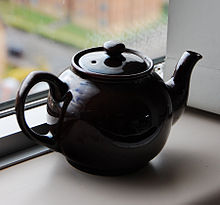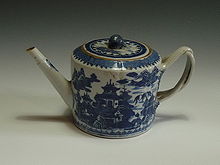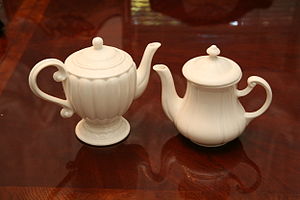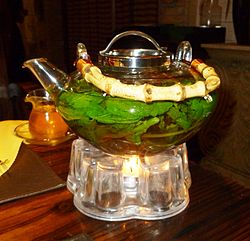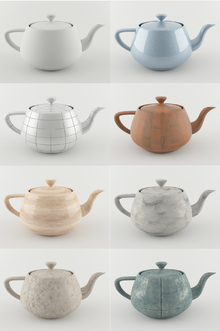
Teapot
About this schools Wikipedia selection
SOS Children, an education charity, organised this selection. Click here for more information on SOS Children.
A teapot is a vessel used for steeping tea leaves or an herbal mix in boiling or near-boiling water, and for serving the resulting infusion which is called tea. Dry tea may be available either in tea bags or as loose tea, in which case a tea infuser or tea strainer may be of some assistance, either to hold the leaves as they steep or to catch the leaves inside the teapot when the tea is poured. Teapots usually have an opening with a lid at their top, where the dry tea and hot water are added, a handle for holding by hand and a spout through which the tea is served. Some teapots have a strainer built-in on the inner edge of the spout. A small hole in the lid is necessary for air access inside to stop the spout from dripping and splashing when tea is poured. In modern times, a thermal cover called a tea cosy may be used to enhance the steeping or to prevent the contents of the teapot from cooling too rapidly.
History
The teapot probably derived from the ceramic kettles and wine pots which were also made in bronze and other metals and were a feature of Chinese cultural life for thousands of years. The teapot was invented during the Yuan Dynasty, tea preparation in previous dynasties did not utilize a teapot. In the Tang Dynasty, a cauldron was used to boil grounded tea, which was served in bowls. Song Dynasty tea was made by pouring water boiled using a kettle into a bowl with finely ground tea leaves. A brush was then used to stir the tea. The innovation of the teapot, a vessel that steeps tea leaves in boiling water, occurs during the late Yuan dynasty. Written evidence of a teapot appears in the Yuan Dynasty text, Jiyuan Conghua, which describes a teapot that the author, Cai Shizhan, bought from the scholar Sun Daoming. By the Ming Dynasty, teapots were widespread in China. The earliest example of a teapot that has survived to this day seems to be the one in the Flagstaff House Museum of Teaware; it has been dated to 1513 and attributed to Gongchun.
Early teapots are small by western standards because they are generally designed for a single drinker and the Chinese historically drank the tea directly from the spout. The size reflects the importance of serving small portions each time so that the flavours can be better concentrated, controlled and then repeated.
From the end of the 17th century tea was shipped from China to Europe as part of the export of exotic spices and luxury goods. The ships that brought the tea also carried porcelain teapots. The majority of these teapots were painted in blue and white underglaze. Porcelain being completely vitrified will withstand sea water without damage, so the teapots were packed below deck whilst the tea stayed on top in the dry.
Tea drinking in Europe was initially the preserve of the upper classes since it was very expensive. Porcelain teapots were particularly desirable because porcelain could not be made in Europe at that time. It wasn't until 1708 that Ehrenfried Walther von Tschirnhaus devised a way of making porcelain in Dresden, Germany, and started the Meissen factory in 1710. When European potteries began to make their own tea wares they were naturally inspired by the Chinese designs.
In colonial America, Boston became the epicenter for silver production and artistry. Among the many artists in Boston, there were four major families in the city's silver market, including Edwards, Revere, Burt and Hurd. Their works of art included silver teapots.
Heat retention
To keep teapots hot after tea is first brewed, early English households employed the tea cosy, a padded fabric covering, much like a hat, that slips over the tea pot. Often decorated with lace or log cabin motifs in the early 1900s, the modern tea cosy has come back into fashion with the resurgence of loose leaf tea ateliers.
Chocolate teapot
A chocolate teapot is a teapot that would be made from chocolate. It is commonly supposed that such a teapot would melt, and be impossible to use, therefore the term is often used as an analogy for any useless item.
In fact, experimental research in 2001 failed to successfully use a chocolate teapot they had made, but later research by The Naked Scientists in 2008 shows that such a teapot can be used to make tea, provided that the walls of the teapot are made over a centimetre thick.
Teapots in non-teamaking contexts
A teapot has a rather distinctive shape, and its fame may sometimes have little to do with its primary function.
- The Utah Teapot is a standard reference object of the computer graphics community, comparable to Hello, World for its popularity. It is included as a graphics primitive in many graphics packages, including AutoCAD, POV-Ray, OpenGL, Direct3D, and 3ds Max.
- Russell's teapot, a skeptic analogy refuting the unfalsifiability of religious claims devised by Bertrand Russell.
- The teapot has been featured in the American children's song from 1939, " I'm a Little Teapot".
- Part of the constellation of Sagittarius contains an asterism (or a star pattern not officially recognized as a constellation) that famously resembles a teapot.
In architecture
- In 2004, a Malaysian cult called the Sky Kingdom constructed a 35 foot tall, cream colored teapot, with an unusually long spout, higher than the pot itself on its property as part of its own private symbolism which included a similarly large blue vase next to the teapot. As part of a crackdown on the sect in August 2005 bulldozers and heavy machinery were sent in to tear down the structure.
- The (purported) world's largest architectural teapot is to be found in West Virginia. In 1938 The Chester teapot was constructed by William "Babe" Devon. The Teapot started its life as a gigantic wooden hogshead barrel for a Hires Root Beer advertising campaign. Devon purchased the barrel in Pennsylvania and had it shipped to Chester, WV where it was set up at the junction of State Route 2 and U.S. Route 30. A spout and handle were added at this time and the wooden barrel was covered with tin to form the teapot's shape. A large glass ball was placed on top to make the knob of the "lid". The Teapot stood in front of Devon's pottery outlet store. Local teenagers were hired to run a concession and souvenir stand which was set up inside the Teapot.

